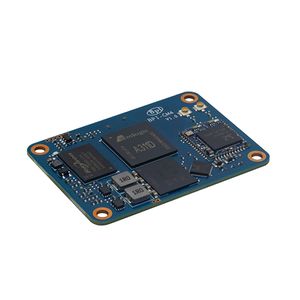Banana Pi BPI-CM4
Contents
BPI-CM4 Introduction

BPI-CM4 Computer module and development Kit with A311D design
BananaPi BPI-CM4 new design with Amlogic A311D Quad core ARM Cortex-A73 and dual core ARM Cortex-A53 CPU ,ARM G52 MP4(6EE) GPU,NPU for AI at 5.0 TOPS, support Camera and MIPI-CSI interface ,HDMI output,2 Gigabit port . 4G RAM and 16 GB eMMC flash.
Key Features
- Amlogic A311D Quad core ARM Cortex-A73 and dual core ARM Cortex-A53 CPU ,ARM G52 MP4(6EE) GPU
- NPU for AI :Next generation, deep-neural-network applications, at 5.0 TOPS
- 4GB LPDDR4 RAM
- 16GB eMMC flash (Max 128G)
- support MIPI DSI Camera interface
- support MIPI CSI Screen interface
- Minipcie
- HDMI output
- 26 PIN GPIO
- support Android and Linux system.
Getting Start
Hardware
Hardware interface
Banana Pi BPI-CM4 SBC specifications
- SoC – Amlogic A311D hexa-core processor with 4x Arm Cortex-A73 cores, 2x Arm Cortex-A53 cores, Arm Mali-G52 MP4 (6EE) GPU with OpenGL ES 3.2, Vulkan 1.0 and OpenCL 2.0 support, 5 TOPS NPU
- System Memory – 4GB LPDDR4
- Storage – 16GB eMMC flash (option up to 128GB), MicroSD card slot
- Video interfaces
- HDMI 2.1 output up to 4Kp60
- MIPI DSI connector for display
- MIPI CSI connector for camera
- Networking – 1x Gigabit Ethernet ports one via RTL8211F GbE transceiver
- USB – 2x USB 2.0 Type-A port, 1x USB Type-C port
- Expansion – 26-pin GPIO header
- Debugging – 3-pin header for serial console
- Misc – 2x buttons.
- Power Supply – Via USB-C port or pin header
GPIO PIN define
Development
Source code
- Linux BSP source code : https://github.com/BPI-SINOVOIP/BPI-M2S-bsp
- Android 9 :https://github.com/BPI-SINOVOIP/BPI-A311D-Android9
Resources
- Banana PI BPI-M2S Amlogic A311D / S922X : https://www.youtube.com/watch?v=9eFXiOtzFl0
- Because of the Google security update some of the old links will not work if the images you want to use cannot be downloaded from the new link bpi-image Files
- All banana pi docement(SCH file,DXF file,and doc)
- Amlogic A311D datasheet: https://drive.google.com/file/d/1SRAY_RDxKhw819uyo9H13zNN2wlG6LDq/view?usp=sharing